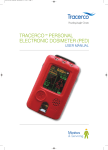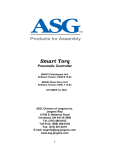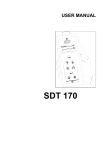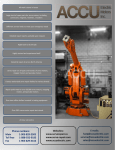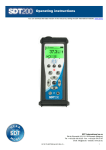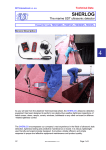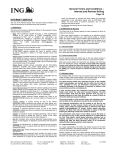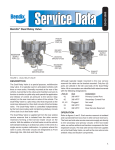Download v Air leak survey handbook
Transcript
Guide for ultrasonic leak detection in compressed air systems in an industrial environment Copyright © 2007 by SDT International n.v. s.a. First edition, English version. All rights reserved. Reproduction in any form of all or part of this document is not permitted without the written permission of SDT International n.v. s.a. SDT International n.v. s.a. Bd. de l’Humanité 415, B – 1190 Brussels (BELGIUM) Tel: ++32.2.332.32.25 Fax: ++32.2.376.27.07 e-mail: [email protected] web page: http://www.sdt.be 2 Contents 1. Detecting compressed air leaks: a double-edged issue. .............................................................................................5 2. Pay for the air you use, not for leaks!..............................7 3. Detecting leaks by listening to the ultrasounds that they produce. .............................................................................9 4. Implementing a campaign to search for leaks and drawing the most benefit from it. ...................................11 4.1 4.2 4.3 4.4 4.5 Devising an effective strategy............................................................ 11 Devising the procedure........................................................................ 12 Choosing appropriate detection equipment..................................... 14 Using the SDT 170 detector properly ............................................... 16 Leaks....but where?.............................................................................. 19 5. Detecting a leak. .....................................................................21 6. Recording the data.................................................................23 7. Quantifying a compressed air loss. .................................25 8. Some practical advice...........................................................37 3 As the indisputable leader in its field, SDT International designs and produces a large range of measuring instruments for the ultrasonic detection and evaluation of various other physical parameters. The company's expertise covers a vast array of applications: large and small capacity tightness tests and for underground tanks, the detection of leaks in any pressure system, production quality control and the detection of wear and faults in the predictive maintenance of mechanical equipment. Our company's success is based on our philosophy and our willingness always to respond to our customers' problems with the most effective, money-saving solutions. 4 1. Detecting compressed air leaks: a double-edged issue. Detecting leaks in compressed air systems is a double-edged issue: an environmental one for each one of us and an economic one for every business. Is it because it's an environmental issue that so few business managers feel worried about the topic? Then let's deal with this issue based on the substantial savings that can be made by eliminating this tremendous waste. A proactive, ultrasonic leak detection campaign amount of compressed air lost can be used to the amount of benefit generated. The figures themselves and will convince you to implement efficiency management programme. quantifying the easily calculate then speak for a better energy When people talk about energy saving prospects the idea of protecting the environment is, however, never very far removed. Detecting leaks in your compressed air systems addresses these two concerns. An environmental and an economic issue. Energy is, and will increasingly become, an important, priority issue because of its price, because supplies are running out and because of the constant fight against climate change etc. In such conditions, why not eliminate completely worthless consumption caused by leaks from compressed air systems? Isn't it time to limit the damage? Especially in view of the fact that the pledges made under the Kyoto Protocol, ratified in February 2005, require us to reduce toxic emissions into the atmosphere by better energy efficiency management. By 2012, 35 industrialised countries have made a commitment to reduce greenhouse gas emissions by 5% compared with their 1990 levels. They represent 35% of global emissions. As such this target is far from being enough. In addition to this no commitment has been made for after 2012. If you listen to Stephane Dion, the retiring President of the United Nations' conference on climate changes, "We would need ten Kyoto agreements to be able to reduce the effects of climate change. Scientists are saying that there must be a 60% reduction in greenhouse gas emissions within the next fifty years to 5 stabilise global warming. Well, if nothing's done, these emissions themselves will increase by 60 %". How much will industry contribute to this? While you're watching your energy bills rise, not a day goes by without new commitments to reduce CO2 emissions' quotas being tackled. A double challenge to be taken up by any manufacturer. All the more so because at the beginning of 2007 the European Union undertook to reduce these types of emissions by 20% at least between now and 2020. Compressed air leaks are very costly in terms of excess consumption of energy. Some awareness, skills within everyone's reach and, above all, good reactions are all that is needed to incorporate energy concerns into one's production tool management. Contrary to what you might think, managing energy better and/ or investing in energy efficiency can be very profitable. And, this doesn't happen very often, a solution that involves eliminating leaks has immediate benefits both for the environment and for your finances. More generally, admittedly, measures aimed at protecting the environment will incur some costs. In this case, on the other hand, this is balanced out by the benefits. And what is more motivating than combining this with the future of generations to come! The detection of leaks in compressed air systems, a measure that is within the grasp of any company, is an important step in its commitment to an active energy management policy. Detecting leaks in compressed air systems Environmental issue. Economic issue. For each one of us and For every business. future generations. 6 2. Pay for the air you use, not for leaks! Compressed air is the most used energy fluid in industry but also the most expensive. Based on 5 years' consumption at a rate of 6,000 production hours a year, it is generally accepted that compressed air production costs are divided into 75 % for the provision of energy, 13 % investment and 12% maintenance costs. Compressed air is expensive for an overall thermodynamic yield (use efficiency) of hardly 10%, even in the best of circumstances. Compressed air production takes 2nd or 3rd place in a company's energy costs. It is therefore natural to take its improvement potential into consideration. It is important and is based essentially on the ideal balance between actual production requirements and pressure levels, on reducing energy losses, on maintaining components, on checking air quality and eliminating leaks in the network. In some companies, rather than thinking about these improvements, they bring in a compressor to compensate for these losses. This is not an unusual situation... Leaks may represent 30 - 40 % of the amount consumed. You must realise that leaks may occur anywhere in the network; online connections, bleed valves, filters, pressure regulators, slide gates, quick release connections, rubber pipes etc. And there are still lots more places in spots that are the most hidden as well as in the most inaccessible places. A real proactive programme to seek out this type of waste is more than vital to reduce the loss to a reasonable amount: 7 Reducing compressed air losses to 5 % of the amount consumed. It's all the more true that if losses prevent minimum service pressure being reached, you very often tend to increase pressure. Which increases the percentage of losses. Taking into account the number of components in any compressed air system, it is easy to imagine the potential for leaks and the financial benefits of a detection campaign. This can be calculated very quickly using the cost of the smallest leaks and by simple multiplication: A single 1 mm leak at 6 bars is already costing you €144 per year. At 12 bars, it will cost you €480 per year. Annual costs of energy caused by an undetected leak*. Hole Ø [mm] Loss Loss of air Loss of air at at of energy 6 bars 12 bars in kWh [l/s] [l/s] at 6 bars Loss of energy in kWh at 12 bars Costs at 6 bars [EUR] Costs at 12 bars [EUR] 1 1.2 1.8 0.3 1 144 480 1.5 2.6 3.7 0.7 2.0 312 987 2 4.8 7.4 1.2 4.1 576 1.973 2,5 7.5 12.8 1.9 7.5 900 3.413 3 11.1 20.8 3.1 12.7 1,488 6,096 Costs to be multiplied by the number of leaks *kWh x 0.06 EUR x 8,000 operating hours per year. 8 3. Detecting leaks by listening to the ultrasounds that they produce. Leaks emit ultrasounds. It is therefore vital to understand what ultrasounds are and how they relate to leaks in order to understand how to detect them properly. Sounds and ultrasounds are mechanical vibrations of matter. Ultrasound is the same type of vibration as sound but at a frequency higher than 20 kHz, which is inaudible to the human ear, which has a range of between 15Hz and 20Hz. Compared with the diffuse emission of sounds, ultrasounds spread in a concentrated fashion in one direction. They can be compared with a beam of light whose intensity decreases depending on the distance. Ultrasounds are generated naturally by fluid turbulence phenomena caused by pneumatic or hydraulic problems (leaks) or by friction phenomena caused by mechanical problems. Electrical problems, such as arcs, corona effects, etc. also generate ultrasounds. In the event of a leak from a compressed air system, the air friction that escapes generates ultrasounds on the sides of the perforation. And it does this whatever the size of the leak, its flow rate and the dimension of the hole, however small it is. Ultrasounds can also be produced artificially using a transmitter to perform tightness tests, for example. As the acuity of the human ear is limited, it is vital to use a detection instrument to listen to ultrasounds, to detect where they are coming from and consequently to locate the leak accurately. 9 The SDT 170 ultrasound detector operating principle. The SDT 170 detects ultrasound signals, converts them into audible frequencies and amplifies them. The aim is to transpose the signal received into an interpretable audible signal using heterodyne technology. This solution extends human hearing capacity beyond the audible range into the ultrasound band. Figure 1 - The main function of the SDT 170 is to convert high frequency signals into audible signals. It must be noted that the detector's central frequency band can be adjusted to a specific frequency between 15.1 and 190.7 kHz ; the default frequency is 38.4 kHz. Figure 2 - The frequency bands are used depending on the type of sound to be detected. For the purposes of detection, the SDT 170 detector is only sensitive to ultrasound vibrations. It restores the turbulence effects, i.e. the actual sound of the leak and it quantifies this leak in dBµV. 10 4. Implementing a campaign to search for leaks and drawing the most benefit from it. A proactive campaign for looking for leaks requires devising a schedule for performing services repeatedly over time. This is completely different from the prompt, unforeseen reactions required by leaks that appear suddenly. This proactive campaign involves using the most appropriate tool and attachments for each location, observing an appropriate methodology, managing the data relating to each leak, documented, validated repair measures and, finally, as far as possible, quantifying leaks and doing the calculation resulting from the campaign. 4.1 Devising an effective strategy The proper management and success of a maintenance programme for your compressed air network is based essentially on the quality of your strategic plan. • DEFINE THE OBJECTIVES - Defining what the objectives are apart from the main one which is to drastically reduce energy costs by only agreeing to a small investment in a detector is vital. Any effective maintenance strategy is necessarily based on a well defined goal. Thus the first question to ask yourself is, quite logically, "What objectives must be achieved by applying a maintenance plan to my compressed air network?" Here are some examples: - Drastically reduce your energy costs with just a small investment. - Detect, quantify the amount and repair any compressed air leak in the existing system. - Restrict the overall amount of losses to 5% of the amount consumed. - Take the strain off your compressors and prolong their lifespan. 11 - Make all the staff in your company aware of the high cost price of compressed air. - Train the users involved in the most effective methods for maintaining the compressed air network. Etc. - • MAKE ALL STAFF AWARE - To achieve maximum efficiency it is important to make all staff aware of this by posting permanent notices about the objectives. These objectives must be spread around the whole company so that each member of staff comes up against them all the time. • RECONSIDER THE WHOLE OF YOUR NETWORK - Managing a maintenance programme for your network is much more than looking for leaks and making repairs. It's also thinking about the network as a whole and making the improvements that are vital for greater efficiency. 4.2 Devising the procedure Your procedure must be devised so that it achieves three results: the safety, reliability and effectiveness of your programme for looking for leaks. For optimum management of your compressed air network, some procedural steps deserve special attention: • SAFETY – This means compiling a procedural manual. Particular attention must be paid to this document. It will specify the frequency of inspections for each control point as well as the most appropriate sensor and attachments for each of these points. The checking procedure will be detailed in five phases: detecting, locating, quantifying, repairing and checking the repair. It will also describe how each person involved must record that he has observed the procedure for each phase and also record information about the leak. • FREQUENCY – An effective annual maintenance plan requires 3 - 4 inspections of all the points of the network. Moving parts or those in a hazardous environment will be checked every month. You will then ensure that you have detected all new leaks as early as possible after they appeared and that you have checked the repairs required by previous inspections. 12 • KNOWING ALL ABOUT THE NETWORK – for yourself and the people involved, knowledge of the network, compressors, the various pressure levels necessary are vital to devising the maintenance plan and observing it. • UPDATING THE CONTROL PLANS – Keeping the installation diagrams up to date will enable you to devise the most appropriate plan of all the points to be checked. All leaks will be recorded there progressively, with their precise location, their frequency, how big they are, the type of repair carried out and the check on this. • CHOICE OF EQUIPMENT – It is important to determine precisely the most appropriate sensors and attachments that must be used for each detection point. • TRAINING – All users of the ultrasound leak detector will have received practical and theoretical training from an experienced person before starting his job. • OBSERVING THE 4 STAGES OF THE PROCEDURE – The four stages of the programme for looking for leaks must be observed; identify, locate, repair, check again. • CHECKING REPAIRS – To be incorporated into the procedure: an ultrasound check of each leak repaired. On the one hand, the person who checks is not always the one who repairs, and, on the other hand, you have to check that another leak hasn't been created accidentally when working on the network. • DATA MANAGEMENT – Quantifying how much is leaking is a difficult matter. From feedback from major users and its specialist expertise, SDT provides you with a unique approach to quantification. Recording such figures with the history of each leak will allow you to compile an annual table of savings generated by your network maintenance. They will also encourage the transfer of skills within your business. 13 4.3 Choosing appropriate detection equipment As specified in the procedure, each check point requires the use of a sensor or the most appropriate fitting. Let us always bear in mind that the ultrasound frequency is low energy and that is spreads in a concentrated way and in a single direction. The most effective ultrasound sensor corresponds to each control and locating situation: • • • • The The The The internal detector sensor flexible sensor EDS (Extended Distance Sensor) adapter parabolic sensor. For easy to get to places All SDT 170 ultrasound detectors are fitted with an open internal sensor to detect compressed air, gas and vacuum leaks. It's the ideal sensor for daily searches and for a quick check of easily accessible places opposite the operator. Several precision attachments (fig.3 nos. 2 5) may help to locate exactly where the leak is. Figure 3 – The SDT 170's internal sensor and the precision attachments. 14 For difficult to get to places This flexible rod with integral sensor has been designed to detect leaks in places deemed to be inaccessible and to get round the parts to be checked. In fact, it can be bent, turned and pointed in any direction. Two lengths available: 550 and 820 mm. Figure 4 – The flexible sensor. Average distance (up to 10 m). Generally, a large part of the compressed air system is located at ceiling level. You need to use a ladder or lifter to inspect it. There is an easier way… The EDS (Extended Distance Sensor) allows you to inspect it while keeping your feet on the ground. This conical shaped adapter is fitted with a threaded tip. It is screwed onto the SDT 170's internal sensor and concentrates the ultrasonic frequencies. It enables better detection at a medium distance and it improves the accuracy of the approach. Figure 5 - The EDS (Extended Distance Sensor) adapter. 15 Long distance (up to 25 - 30 m). If the place to be inspected or the leak to be located is out of range of the detector in spite of using the EDS (fig. 5), you can use this parabolic sensor. This is a high precision signal concentrator which enables detection at very long distances. This transparent plexiglas parabola is fitted with a particularly sensitive sensor. It has two sights for extremely accurate location: one is a "rifle" sight and the other a powerful laser sight. Figure 6 – The parabolic sensor and its laser sight. 4.4 Using the SDT 170* detector properly 1. If you don't use the SDT 170 detector's internal sensor, connect the selected sensor to the connection for the external sensor. Then connect the headphones to the unit's audio output. You must use these to search for the leak, to locate it and to be able to quantify it. You will also be protected from surrounding parasitic noises. 2. Start the apparatus (fig. 8 page 18). 16 3. Ensure that the sensor connected is automatically recognised by the SDT 170 unit. The sensor ID is displayed in the top left corner of the screen (fig. 7, Type of sensor). Figure 7 – The LCD display 4. Check the battery level on the icon in the upper right corner of the screen (fig. 7). 5. After the company safety procedures have been performed, you start detecting leaks as described in Chapter 5. *All details in the user manual supplied with the unit. The importance of the digital display. Your SDT detector display or a digital the digital display economic approach may be fitted with a screen with a bar graph display for measuring the leak. More precisely, is vital for quantifying leaks in view of an following your strategy for finding leaks. Apart from the fact that measures can be traced and it is very userfriendly, there are many advantages from saving data and transferring it to a PC. Some versions have this option. 17 Figure 8 – The basic functions of the SDT 170 18 4.5 Leaks....but where? Leaks may occur anywhere in your compressed air system! A look at the top twelve most common leaks: 1. Connections on the supply line. 2. Quick coupler 3. Filters 4. Pneumatic cylinders. 5. Regulator/dryer assembly 6. Pressure regulators 7. Rubber pipes 8. Regulator/lubricator assembly 9. Isolation valves 10. Control valves 11. Automatic drain traps 12. Various pipes As a rough guide, the table below gives you the distribution of compressed air used in industry where there is absolutely no proactive predictive network maintenance programme. Distribution of the amounts of compressed air used in industry (international averages) Consumption by equipment 43 % Leaks into the atmosphere 34 % Inappropriate uses 16 % Purged air 5% Failed drain traps 2% These figures are averages drawn up by Plant Support & Evaluations Inc. – Audit Division 19 20 5. Detecting a leak. The detection service as such requires the application of some basic principles aimed mainly at efficiency and ease of work. • For repeating and comparing measures you will always use the same sensor and/or attachment for the same place to be tested. • The unit's level of amplification will be selected depending on the working environment. • The exact location will be determined by sweeping in all directions searching for the strongest ultrasound signal. This is when the highest value appears on the screen. It's simple and intuitive given that it's actually the noise of the leak that you are hearing. • If it is not to be repaired immediately you will have to provide an exact location of the place. • Each repair must be checked as must the immediate surroundings. Procedure: 1. Start searching with maximum amplification, sweeping from the top to the bottom and from left to right with the unit or the sensor that you have connected to the unit, in order to locate the leak accurately. Detecting the hissing sound that is typical of ultrasounds indicates that there is a compressed air or vacuum leak. If the signal detected is too powerful, reduce the amplification level to make it more comfortable to work. 2. As soon as you detect the hissing sound, move the sensor closer to the source to locate the leak. Press the down arrow to reduce the signal level given that it will increase as you approach the precise location of the leak. 21 3. This will be at the place where the signal is most powerful and when the highest value is displayed on the screen. 4. Select the amplification level depending on your working environment so that you do not have either of the two indicator arrows on the screen of the SDT 170. They may, still be there when the amplification level is at its maximum (A=80) or at its minimum (A=10). 5. Note down or save the leak measurement (dBµV) displayed on the screen. 6. Report this precise spot if the leak is to be repaired immediately or mark it with a locating mark if it is to be repaired later. 7. Note down as much information as possible about the leak: the place, the type of leak, how big it is, the identity of the inspector and the repairer are very useful items to note down. Compressed air is expensive. Compressed air losses = waste! 1. Controlling this energy vector is an absolute necessity. Compressed air is expensive. 2. Compressed air costs €0.6 - 3.0 per Nm³ depending on the optimisation of the plant. 3. The overall thermodynamic efficiency (efficiency of use) of a plant is very low: only ± 10 % on average taking into account energy leakage, motor, transmission and compressor losses, load losses and leaks. The potential for improvement is therefore very great. 22 6. Recording the data. Recording data relating to each leak inspected is a vital step in your campaign to search out leaks. It must be incorporated into your maintenance plan with the option to add records appropriate for your strategy which will meet the objectives of each campaign. Example of an internal data record sheet for an inspected leak. COMPANY LOGO Detecting compressed air leaks: DEPARTMENT: ................................................ MACHINE (or premises): .................................. INSPECTOR: ……………………………………. SENSOR: ………………………………………… MEASURING DISTANCE: ……………………… Date and inspector Department Leak number Description and location Size of the leak in dBµV 23 Loss of air in L/h Air loss €/y /y Person responsible and date of repair Person responsible and date of second check Data recorded for the inspected leak: Date and inspector Date and name of the person responsible for checking leaks. Department Part of the plant in which the inspection took place (e.g. production workshop, packaging unit etc.). Leak number Number on the leak locating mark. Description/location Description and location of the leak (e.g. on the left side of the T at the outlet of boiler no. XXX or at the inlet to pump no. YYYY, see diagram Z). Size of the leak in dBµV The value measured and displayed on the detector screen. Air loss in L/hour See tables from page 28 "Quantifying a compressed air loss". Air loss in €/year If you have the cost prices of compressed air in your company you can easily estimate the annual financial loss resulting from this leak. Person responsible and date of repair Actual date the repair was finished and the name of the person who carried it out. Person responsible and date of re-check Date the repaired leak underwent a second ultrasound check and the name of the inspector. 24 7. Quantifying a compressed air loss. Quantifying a leak by converting the dBµV into L/y or into SCCM/SCFM is to be planned with the greatest care. It should only be undertaken by competent people who have been trained appropriately. Given that a very large number of factors may influence the taking of measurements in dBµV, it goes without saying that the user of this type of measuring equipment will first of all include all of these factors so that he can take account of them when he makes his conclusions on quantifying a detected leak. When detecting leaks in an industrial environment, certain factors may influence the measurements: The leak orifice size, its shape, its configuration. The surrounding parasitic ultrasound signals. The distance between the leak and the sensor. The position and the working angle of the sensor in relation to the leak axis. The features of the ultrasound sensor and the conditions under which it is used. The temperature and humidity level of the air escaping from the leak. … and very many more. 25 Quantifying compressed air losses also means evaluating the savings made. The big question that's asked most often is "Looking for leaks is all very well. But what good is it going to do me? Is it really worth the effort?" Under certain conditions the method enables each leak detected to be quantified and the gains to be had from its repair to be calculated. There is nothing more gratifying that to be able to compile a quarterly or annual table of savings made by your network maintenance services, in the certainty that energy efficiency is being managed better and there will be a rapid return on investment. In the tables below you will find the values in dBµV measured for a determined compressed air leak whatever the pressure up to 10 bars inclusive. • The dBµV measurements in the first two tables are the results of detecting with the internal sensor or the flexible sensor using an SDT 170 S+, M, M+ or MD unit, given that the 170 S model does not have a digital display of the measured value. • The dBµV measurements in the third and fourth tables are the results of detecting with the parabolic sensor, using one of the units mentioned in the previous paragraph. • All SDT detectors have been used in the default 38.4 kHz central frequency band. • The dBµV values were recorded at the loudest level of the leak. They are, therefore, maximum values. You will note that when using the SDT detector in an industrial environment, this noisiest level is rarely detected perpendicular to the leak, but most often at an angle of about 30° to the axis of the leak. An increase in pressure automatically causes an increase in flow. And, at the same time, the ultrasound signals measured in dBµV by the SDT 170 detector also increase. You can, therefore, favourably deduce from this that quantifying leaks based on the SDT 170 measurements is independent of the level of pressure used (not always known). 26 Details of the leak used: Leak orifice: from 0.2 - 1 mm Area: from 0.033 - 0.822 mm² Important note: The values in these tables are given as a rough guide and may only be used as guidelines to make the task easier. 27 Quantifying a compressed air loss. Measurements with the internal SDT 170 sensor or the flexible sensor. 1 - 6 bars inclusive 0.4 m dBµV 90 80 70 60 50 40 30 20 10 L/h 0 0 500 1000 1500 2000 28 2500 3000 3500 dBµV L/h SCCM SCFM 20 141 2355 0.083 22 158 2627 0.093 24 176 2931 0.104 26 196 3270 0.115 28 219 3647 0.129 30 244 4069 0.144 32 272 4539 0.160 34 304 5063 0.179 36 339 5648 0.199 38 378 6301 0.223 40 422 7029 0.248 42 470 7841 0.277 44 525 8747 0.309 46 585 9758 0.345 48 653 10885 0.384 50 729 12143 0.429 52 813 13546 0.478 54 907 15111 0.534 56 1011 16858 0.595 58 1128 18805 0.664 60 1259 20978 0.741 62 1404 23402 0.826 64 1566 26106 0.922 66 1747 29123 1.028 68 1949 32488 1.147 70 2174 36241 1.280 72 2426 40429 1.428 74 2706 45100 1.593 76 3019 50311 1.777 29 Quantifying a compressed air loss. Measurements with the internal SDT 170 sensor or the flexible sensor. 1 - 10 bars inclusive 2m dBµV 90 80 70 60 50 40 30 20 10 0 0 1000 2000 3000 4000 30 5000 L/h 6000 dBµV L/h SCCM SCFM 10 225 3745 0.132 12 250 4169 0.147 14 278 4641 0.164 16 310 5167 0.182 18 345 5753 0.203 20 384 6404 0.226 22 428 7130 0.252 24 476 7938 0.280 26 530 8837 0.312 28 590 9838 0.347 30 657 10953 0.387 32 732 12194 0.431 34 815 13575 0.479 36 907 15113 0.534 38 1010 16826 0.594 40 1124 18732 0.662 42 1251 20854 0.736 44 1393 23217 0.820 46 1551 25847 0.913 48 1727 28776 1.016 50 1922 32036 1.131 52 2140 35665 1.260 54 2382 39706 1.402 56 2652 44205 1.561 58 2953 49213 1.738 60 3287 54789 1.935 62 3660 60996 2.154 64 4074 67907 2.398 66 4536 75600 2.670 68 5050 84165 2.972 70 5622 93701 3.309 31 Quantifying a compressed air loss. Measurements with the SDT 170 and the parabolic sensor. 5 - 10 bars inclusive 2m dBµV 90 80 70 60 50 40 L/h 30 0 1000 2000 3000 32 4000 5000 6000 dBµV L/h SCCM SCFM 65 756 12600 0.445 66 855 14250 0.503 67 956 15933 0.563 68 1059 17650 0.623 69 1165 19417 0.686 70 1274 21233 0.750 71 1385 23083 0.815 72 1500 25000 0.883 73 1618 26967 0.952 74 1740 29000 1.024 75 1866 31100 1.098 76 1996 33267 1.175 77 2132 35533 1.255 78 2274 37900 1.338 79 2422 40367 1.426 80 2580 43000 1.519 81 2744 45733 1.615 82 2920 48667 1.719 83 3110 51833 1.831 84 3318 55300 1.953 85 3548 59133 2.088 86 3810 63500 2.243 87 4125 68750 2.428 88 4550 75833 2.678 33 Quantifying a compressed air loss. Measurements with the SDT 170 and the parabolic sensor. 5 - 10 bars inclusive 5m dBµV 90 80 70 60 50 40 30 L/h 20 0 2000 4000 34 6000 8000 dBµV L/h SCCM SCFM 56 944 15733 0.556 57 1052 17533 0.619 58 1164 19400 0.685 59 1280 21333 0.753 60 1400 23333 0.824 61 1516 25267 0.892 62 1632 27200 0.961 63 1770 29500 1.042 64 1902 31700 1.120 65 2040 34000 1.201 66 2186 36433 1.287 67 2333 38883 1.373 68 2490 41500 1466 69 2656 44267 1.563 70 2830 47167 1.666 71 3016 50267 1.775 72 3217 53617 1.894 73 3438 57300 2.024 74 3682 61367 2.167 75 3964 66067 2.333 76 4305 71750 2.534 77 4776 79600 2.811 35 Table correlating the diameter of the leak, its volume and the loss of energy. Diameter of the leak Volume of air lost at 6.2 bars Power required mm inch L/h SCCM SCFM kW 1.6 1/16 3 570 59 466 2.1 0,3 3.2 1/8 36 040 600 320 21.2 3,1 6.4 1/4 97 240 1 619 732 57.2 8,3 9.5 3/8 222.5 33 378 250 6 300 533 Information source for this table: Atlas Copco Compressed Air. Annual cost in electricity for the compressor power supply. Pk kWh Cost (EUR) Cost (USD) 5 3.7 1 196 1 415 10 7.4 2 391 2 830 20 14.7 4 712 5 576 30 22.1 7 102 8 405 60 44.2 14 134 16 727 100 73.6 23 628 27 962 150 110.4 35 442 41 943 300 220.8 70 814 83 803 500 368.0 117 998 139 643 700 515.2 165 254 195 567 1000 736.0 236 068 279 370 Base 24h/24h=8,760 h/year Price:€0.037/kWh 36 8. Some practical advice. 1. Use simple screen effect techniques in order to eliminate any parasitic noise. Ultrasounds are directional, in other words, they spread in one direction only. Use your body or a piece of cardboard to make a screen between the parasitic ultrasound (from the bleed valve for example) and the place where you are trying to detect the leak. Put a rag or your hand above the sensor in order to indicate the exact location of the leak. 2. Be careful of reflection phenomena. When looking for a leak it seems sometimes that the leak is coming from a wall, a partition, the ground or a place where it is obvious that no ultrasound is being created. We are then faced with the laws of reflection. Ultrasounds are partially absorbed by the material on which they are reflected and partially reflected by this material. When faced with a reflection phenomenon, you must estimate the angle of reflection and place yourself in the direction of the angle of incidence (the direction the leak is coming from). In relation to the reflection surface the two angles are equal. When looking for the leak in the direction of incidence the height where it is detected in the headphones should be higher than the height detected in the direction of reflection. 3. Absorption of ultrasound. As we have already described in the trick above, part of the ultrasound signal is absorbed by the object on which the ultrasounds are reflected. This absorption factor depends entirely on the material of the object on which the ultrasound signals are reflected. A fabric-covered surface absorbs the sound much more or reflects it much less than a concrete or metal surface. 37 4. Locating a leak precisely. It isn't normally enough to stop detecting a leak a few centimetres away from the assumed leak. In order to locate the leak precisely you must always check the area surrounding it because the precise location of the leak may be in the same direction as the one you were looking for. All the more so if a compressed air system is behind a pipe or a flange. This is why it is advisable to carry out an inspection of the area all around the suspected leak. 5. Quantifying leaks. To quantify leaks as accurately as possible you must always start from the maximum dBµV value. This is equivalent to the highest leak sound detected. Only the highest value can be considered, recorded in the internal memory and then transferred to the computer. By inserting these values in the appropriate Excel lists, it becomes easy to calculate the total air loss (loss in €). 38 39 Detecting leaks in compressed air systems is a double-edged issue: an environmental one for each one of us and an economic one for every business. Is it because it's an environmental issue that so few business managers feel worried about the topic? Then let's deal with this issue based on the substantial savings that can be made by eliminating this tremendous waste. A proactive, ultrasonic leak detection campaign quantifying the amount of compressed air lost can be used to calculate the amount of savings made. The figures then speak for themselves and will convince you to implement a better energy efficiency management programme. Eliminating compressed air leaks has immediate benefits both for the environment and for your finances. More generally, admittedly, measures aimed at protecting the environment will incur some costs. In this case, on the other hand, this is balanced out by the benefits. And what is more motivating than combining this with the future of generations to come! The detection of leaks in compressed air systems, a measure that is within the grasp of any company, is an important step in its commitment to an active energy management policy. The solution is there. It is simple and easy to implement. It enables you to make substantial savings and goes well beyond eliminating a great waste of energy. And however, compressed air is still often forgotten when programmes for reducing production costs are drawn up. André DEGRAEVE, Manager SDT International SDT International s.a. Bd. de l’Humanité 415, B – 1190 Brussels (BELGIUM) Tel: ++32.2.332.32.25 Fax: ++32.2.376.27.07 e-mail: [email protected] web page: http://www.sdt.be








































